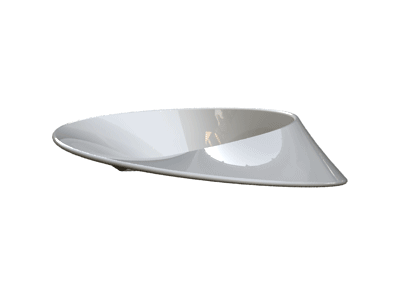The Möbius Band is an example of one-sided surface in the form of a single closed continuous curve with a twist. A simple Möbius Band can be created by joining the ends of a long, narrow strip of paper after giving it a half, 180°, twist, as in Figure 1. An example of a non-orientable surface, this unique band is named after August Ferdinand Möbius, a German mathematician and astronomer who discovered it in the process of studying polyhedra in September 1858. But history reveals that the true discoverer was Johann Benedict Listing, who came across this surface in July 1858.
A Möbius strip embedded in Euclidean space is a chiral object with right- or left-handedness. The Möbius strip can also be embedded by twisting the strip any odd number of times, or by knotting and twisting the strip before joining its ends.
Definition– The Möbius strip Ma (with height 2a) was defined as an abstract smooth manifold made as a quotient of (−a, a)×S1 by a free and properly discontinuous action by the group of order 2. Our purpose here is to work out some tangent space calculations to verify that the explicit “definition” of the Möbius strip via trigonometric parameterization is really a smooth embedding of our abstract Mobius strip of height 2a into R3.
Using the C^∞ isomorphism between R/2πZ and the circle S1 ⊆ R2 via θ → (cos θ,sin θ) (which carries θ → π + θ over to w → −w on S1), we consider the standard parameter θ ∈ R as a local coordinate on S1. For finite a > 0, consider the C^∞ map f : (−a, a) × S1 → R3 defined by,
(t, θ) → (2a cos 2θ + t cos θ cos 2θ, 2a sin 2θ + t cos θ sin 2θ, tsin θ).
Since f(−t, π + θ) = f(t, θ) by inspection, it follows from the universal property of the quotient map (−a, a) × S1 → Ma that f unique factors through this via a C^∞ map f : Ma → R3. Our goal is to prove that f is an embedding and to use this viewpoint to understand some basic properties of the Möbius strip.


The C^∞ inclusion S1 → (−a, a) × S1 via θ → (0, θ) is compatible with the antipodal map on S1 and with the map (t, θ) → (−t, π + θ) on (−a, a) × S1, so we get an induced C∞ map on quotients that is a closed C^∞ sub-manifold (by the general good behavior of “nice” group-action quotients and closed sub-manifolds, as explained in the handout on quotients by group actions). Near the end of the handout on quotients by group actions, it was shown that the squaring map w → w2 from S1 to S1 gives a C^∞ isomorphism of S1 with the quotient of S1 by the antipodal map w → −w. Thus, we get a quotient circle C as a C∞ closed sub-manifold in Ma (the image of {0}×S1 ⊆ (−a, a)×S1).
Inside of the “real world” model f(Ma), the central circle is f(C), and so the assertion of interest is that f(Ma) − f(C) is connected. Since f is a homeomorphism onto its image, it is equivalent to say that the abstract complement Ma − C is connected. Note that it is crucial we worked with f and not f, since C = f({0} × S 1 ) yet (−a, a) × S 1 − {0} × S 1 = ((−a, a) − {0}) × S1 is disconnected. (There is no inconsistency here, since f is not even injective, let alone an embedding, so it could well carry a disconnected subset of its source onto a connected subset of its image.) To see the geometry of Ma − C, we look at the map ((−a, a) − {0}) × S 1 → Ma − C. This map is the quotient by (t, θ) → (−t, θ + π), so the formation of this quotient simply involved identifying (−a, 0)×S 1 with (0, a)×S 1 via (−t, θ) ↔ (t, π +θ) for 0 < t < a. More specifically, the connected component (0, a) × S 1 maps onto Ma − C via a bijective C^∞ local isomorphism, so this map is necessarily a C^∞ isomorphism. Thus, Ma−C is connected since (0, a)×S 1 is connected. Note that the subset f(Ma)−f(C) is exactly f((0, a)×S 1 ), with the map f : (0, a)×S1→ f(Ma)−f(C) a homeomorphism (and even a C^∞ isomorphism).





